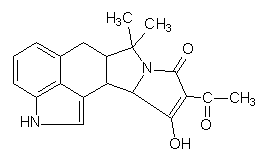ToxicBlackMould
Information about mould and mould disease
Cyclopiazonic acid

Most of the organisms involved in producing of cyclopiazonic acid are important storage fungi growing saprophytically? on grain or they may be important plant pathogens. Cyclopiazonic acid has been detected at levels up to 10 mg/kg or higher in maize, millet, peanuts, pulses, cheese, ham, sausage, frankfurters, mixed feeds, hay, tomato, milk and other foods and feeds. Some cheeses are surface ripened with the species P. camembertii that can produce cyclopiazonic acid.
Cyclopiazonic acid was found to be produced by several Penicillium and Aspergillus species. The penicillium species involved include P. cyclopium, P. puberulum, P. viridicatum, P. chrysogenum, P. crustosum, P. patulum, P. griseofulvum, P. commune, P. camembert and P. palitans. The main producers of cyclopiazonic acid from the Aspergillus moulds are Aspergillus flavus, A. versicolor, A. oryzae and A. tamarii. Because it can be formed by A. flavus, a species that is a major producer of aflatoxins, it has the potential to co-occur with these mycotoxins? in a range of commodities. Cyclopiazonic acid only appears to be toxic in high concentrations and its significance for human health has not yet been fully appraised.Cyclopiazonic acid causes convulsions, degenerative changes and necrosis? in the liver, spleen, pancreas, kidney, and other organs of many animals. This mycotoxin has been detected in kodo millet seeds in India, where it was implicated in the human disease ‘Kodua Poisoning’, and it have been added to the category of potentially serious mycotoxins?. Poisoning in humans is associated with symptoms of nervousness, lack of muscle coordination, staggering gait, depression, spasms, sleepiness and giddiness which may last for 1-3 days. It has similar pharmacological properties to the anti-psychotic? drugs.
Cyclopiazonic acid accumulates in skeletal muscle of selected animals and human exposure may occur through ingestion on contaminated muscle tissue. It has been shown to be toxic in several animal species including swine, chickens, turkeys, guinea pigs, rats, and dogs. Toxic evidence in animals, depending upon the species, includes gastrointestinal changes of necrosis? and inflammation, hepatitis? , kidney lesions and in-coordination due to effects on muscle tissue
Chemical properties and toxicology
Cyclopiazonic acid (C20H20N2O3) is a toxic indole tetramic acid which has been suggested to derive from triptophan and enzymes that catalyze important steps in its biosynthesis have been isolated from P. cyclopium. In its pure form it comes as a white to off-whote hygroscopic? powder soluble of chloroform, dichloromethane, methanol and acetonitrile, and sodium bicarbonate. It is stable in dry state if stored at +4 Deg C.
In its pure form it comes as a white to off-whote hygroscopic? powder soluble of chloroform, dichloromethane, methanol and acetonitrile, and sodium bicarbonate. It is stable in dry state if stored at +4 Deg C.
Cyclopiazonic acid is a specific inhibitor of Ca2+-ATPase in the intracellular Ca2+ storage sites. It has been found to be a neurotoxin? when injected intraperitoneally? into rats and the LD50 in male rats was 2.3 mg/kg
